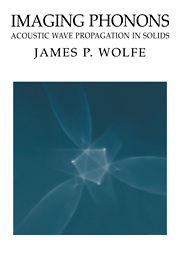Book contents
- Frontmatter
- Contents
- Preface
- Prologue – Anisotropic heat flow in crystals
- 1 Ballistic heat pulses and phonon imaging – A first look
- 2 Phonon focusing
- 3 Generation and detection of phonons – Experimental aspects
- 4 Focusing in cubic crystals
- 5 Acoustic symmetry and piezoelectricity
- 6 Lattice dynamics
- 7 Imaging of dispersive phonons
- 8 Phonon dynamics
- 9 Bulk scattering of phonons – Experiments
- 10 Quasidiffusion and the phonon source
- 11 Phonon scattering at interfaces
- 12 Refraction and reflection at solid/solid interfaces – Experiment
- 13 Imaging ultrasound in solids
- 14 Imaging surface acoustic waves
- 15 Interactions of ballistic phonons with electrons
- Appendix I Algebraic solution to the wave equation
- Appendix II Abbreviated tensor notation and group velocity
- Appendix III Survey of phonon focusing in cubic crystals
- Index
Preface
Published online by Cambridge University Press: 24 March 2010
- Frontmatter
- Contents
- Preface
- Prologue – Anisotropic heat flow in crystals
- 1 Ballistic heat pulses and phonon imaging – A first look
- 2 Phonon focusing
- 3 Generation and detection of phonons – Experimental aspects
- 4 Focusing in cubic crystals
- 5 Acoustic symmetry and piezoelectricity
- 6 Lattice dynamics
- 7 Imaging of dispersive phonons
- 8 Phonon dynamics
- 9 Bulk scattering of phonons – Experiments
- 10 Quasidiffusion and the phonon source
- 11 Phonon scattering at interfaces
- 12 Refraction and reflection at solid/solid interfaces – Experiment
- 13 Imaging ultrasound in solids
- 14 Imaging surface acoustic waves
- 15 Interactions of ballistic phonons with electrons
- Appendix I Algebraic solution to the wave equation
- Appendix II Abbreviated tensor notation and group velocity
- Appendix III Survey of phonon focusing in cubic crystals
- Index
Summary
Because matter is composed of light and heavy particles – namely, electrons and nucleons – the properties of solid materials naturally divide into two main categories: electronic and vibrational. For the most part, the rapid motion of electrons governs the binding and elasticity of a solid, its conductivity, and its optical and magnetic properties. In contrast, the more sluggish motion of the atomic nuclei determines the vibrational properties of a solid. The descriptions of electronic and nuclear motion in solids are generally developed in terms of wave motion. Such waves in solids are most easily understood for well-ordered systems such as crystals, where the atoms are arranged in regular arrays.
This book is about vibrational waves in crystals – more specifically, those classified as acoustic waves. These are the waves that depend on the elasticity of the medium and whose frequencies extend from zero to a few terahertz (1 THz = 1012 Hz). Experimental probes of the motion of acoustic waves in solids traditionally range from ultrasonics to thermal conductivity. The major focus of this book is the propagation of phonons – the tiny packets of vibrational energy associated with heat and typically observed in the frequency range from 1010 to 1012 Hz. The propagation of ultrasonic waves in the megahertz range will also be examined here using imaging techniques initially developed for high-frequency phonons.
Phonons govern the thermal properties of nonmetallic solids. At normal temperatures their motion is highly diffusive.
- Type
- Chapter
- Information
- Imaging PhononsAcoustic Wave Propagation in Solids, pp. ix - xivPublisher: Cambridge University PressPrint publication year: 1998

